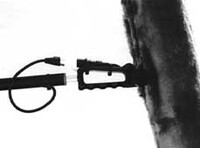Tips on using your boompole
Amount of Extension
How long a boompole you will need really depends on the type of production you will be doing. Feature films, commercials, and episodic television calls for a long reach, around 12 to 15 feet, in order to cover the set. News gathering and “run & gun” documentary style traditionally only require a shorter reach, around 5 to 8 feet, since the camera crew is more mobile and working close-in.
Whenever you extend a boompole, do not lock the pole sections extended all the way to the safety stops. The proper technique for achieving maximum reach is to slide the pole section to the stop, and then back it in a couple of inches. A slight overlap will make the pole sturdier (no wilting at the locking collars) and quieter.
Another good practice is to extend the pole further than what you need for the shot so that you can grip the boompole closer to its center of gravity (think of a circus tightrope walker’s balance pole). By letting the pole counterbalance itself in your hands, your muscles will not be exerting to overcome torque. Some boompole manufacturers, such as K-Tek, even offer weights that attach to the bottom of poles to achieve more comfortable balance.
Preventing Cable Noise
Cable noise in a boompole can originate from three problems: conductance, percussion, and loose connections.
Conductance is noise or rumble (physical vibrations) that travel along the sheath of the cable. To prevent this, the inside tube section of the boompole should be foam dampened. For instance, in the poles that I use, the cable is fully enveloped in compressed foam rubber for the entire length of the inside section. Note that you cannot line the remaining sections of the pole, or it will not be able to telescope.
To maintain the pliability and cleanliness of the mic cable, routinely wipe it down with a restorative solution such as Armor All™.
Percussion is noise created by the cable banging against the remaining tube sections of the boompole. Since the pole telescopes, it is impossible to foam dampen any but the innermost tube.
The best technique for controlling cable percussion (on poles that have internal cables that flow out of the side or bottom) is to keep the cable taut while holding the boom. As the cable exits from the pole, loop it around the little finger or thumb of your supporting hand and keep the line snug. Do not allow the cable to merely exit the pole and drop to the floor!
 If your boompole has an internal coiled cable, then the entire cable is kept fully contained inside of the pole. There is nothing that you can do to reduce the coil from colliding with the sides of the tube, other than trying to keep the pole at full extension as much as possible. Internally coiled cables are very convenient, but are inherently noisier than flow-thru cables. We find that coiled cables are more common for news, documentary, and reality shows; flow-thru cabling is more popular on feature film sets.
If your boompole has an internal coiled cable, then the entire cable is kept fully contained inside of the pole. There is nothing that you can do to reduce the coil from colliding with the sides of the tube, other than trying to keep the pole at full extension as much as possible. Internally coiled cables are very convenient, but are inherently noisier than flow-thru cables. We find that coiled cables are more common for news, documentary, and reality shows; flow-thru cabling is more popular on feature film sets.
The final cause of cable noise can be the mic connection. XLR connectors on mics as well as cables have been known to loosen from continuous usage. Place a strip of cloth camera tape over the junction where the microphone connects to the boom cable to protect against intermittent connection occurring when the mic is moved around.
Always maintain some slack in the cable connection between boompole and microphone. A taut cable will conduct handling noise.
On the same token, too much excess cable can flap around and cause noise. This excess can simply be wrapped once or twice around the pole beneath the shockmount.
 The cable on some poles may be cable-tied in a small loop where it exits the tip of the pole in order to reduce conductance as well as to serve as a strain relief.
The cable on some poles may be cable-tied in a small loop where it exits the tip of the pole in order to reduce conductance as well as to serve as a strain relief.
Another useful trick is to use a short jumper cable inside of your blimp windscreens. This cable should terminate at the handle of your shockmount, and be permanently attached with cable ties or tape. It will simplify the process of mounting your shockmount to the pole, because it will no longer be necessary to open up the windscreen and dress the cable every time you need to use the mic.
